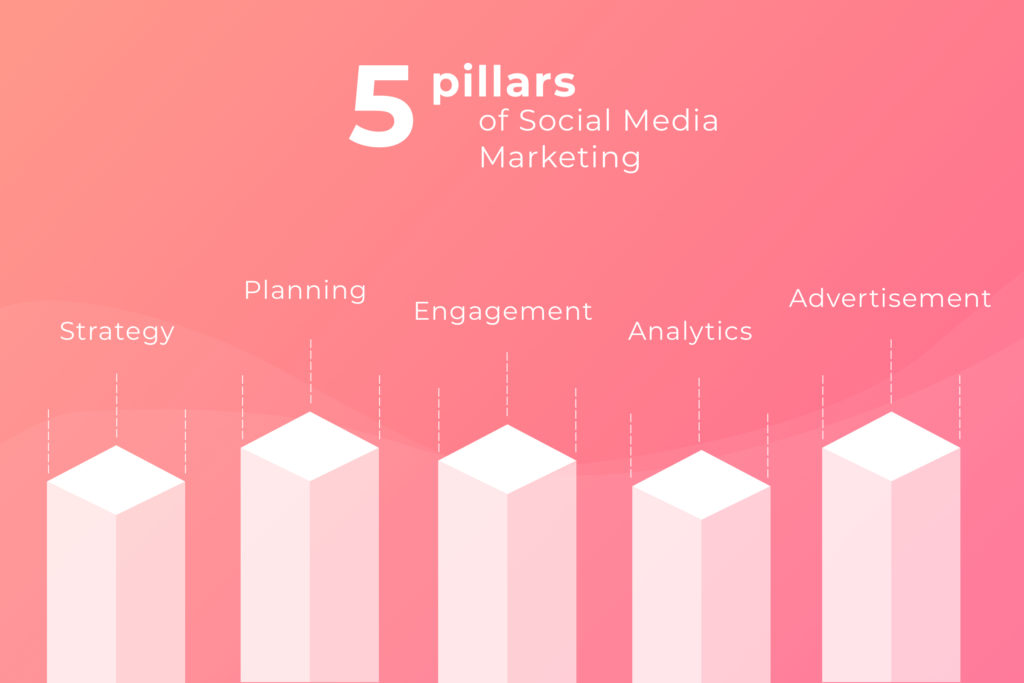5 Pillars of Social Media Marketing
Fundamental pillars of Social Media Marketing: There’s no doubt about it: Your business needs to be active on social media these days, and you need to focus at least a portion of your marketing efforts (and budget) on your social media strategy.
With 4.48 billion people owning social media accounts, there is a whole world of potential customers that any business can access just by logging in and creating brilliant content. Brands like BooHoo, Depop, and Chipotle excel at social media, and there’s a simple reason: They integrate the core pillars of social media marketing.
There are 5 main pillars. Let’s go through them one by one~
1. Strategy:
A solid social media marketing strategy is the backbone of your social media presence. Without a strategy, you’re wasting time, you’re unlikely to achieve your goals, and you’ll most likely struggle to reach your target audience. In case you’re not sure, one content strategy is to offer the “right content, to the right people, at the right time.”
In its most basic terms, a content strategy helps you achieve your business goals by enabling you to:
~ Create valuable content
~ Encourage involvement
~ increase conversions
A good social media marketing strategy has clear goals, and specific plans for achieving them, and should be measurable. Finally, you should set some benchmarks to see how things are going and if you need to change your approach.
2. Planning and Publication:
Social media is a powerful tool, but you can’t just go out and post content without a plan behind it.
When planning content, make sure:
~ Know your audience: You need to know the demographics of your audience to connect with them.
~ Focus on quality: Content quality is just as important as quantity.
~ Consider your brand: Staying consistent with your brand values is crucial.
~ When it comes to publishing, there is one golden rule: consistency. A regular posting schedule keeps people coming back for more.

3. Listening and Engagement:
Plan your content and most importantly, really engage with your audience. Your feedback isn’t always positive; but if you don’t make any changes, the tone of your answers won’t change either. Listening and engaging is part of a successful digital transformation, especially when looking to improve the overall customer experience.
It’s also worth noting that social listening isn’t just about customer experience. It can allow you to:
~ Capture new trends
~ Identify new sources of revenue
~ Get industry insights
~ Find influencers in your niche
Need help getting started with social listening? Hootsuite offers a free introductory tool for measuring keywords and hashtags.
4. Analytics:
The success of any social media marketing campaign depends on analytics to track and collect data. Without this information, you cannot:
~ Understand user behaviour
~ Refine your strategy
~ Find out which platform works best for your brand
~ Find out the best times to post
~ Analyze your competitors
If you have all of these, you’ll know for sure what works and what doesn’t. This way you can spend more time working and less time wasting. The analytics, in turn, will influence your decisions for future campaigns – and greatly influence the success rate.
Likewise, A/B testing is great for determining which content, designs, CTAs, etc. work better. If you’ve noticed that some types of content get twice as much engagement as other posts, take advantage of them.
For example, if you run a small business, your followers will most likely be family and friends who will love the personal insight and celebratory posts because they care about you and your successes. Producing high-quality content that your audience isn’t interested in means engagement levels go down. You should work on getting your posts to appear in people’s feeds before you start browsing those insightful industry blogs.
5. Advertising:
For anyone looking for an audience, it pays to explore social media advertising. With around 2.89 billion monthly active users on Facebook alone, that’s an incredible amount of potential customers.
The three main types of social media advertising are:
Organic: content that naturally collects views and that you don’t pay for.
Paid: Content that an organization sponsors and therefore costs money to publish.
Earned: Content given away for free in the form of shares, likes and comments.
There are several ways to advertise on social media. For example, you can:
Create content: This includes posts and videos.
Promote Content: Create posts that are promoted/sponsored.
Engage with people: Be active in industry-related groups, interact with influencers in your industry, etc.
Grow your audience: Get people in your industry to follow your brand by creating and sharing content that resonates with them.
Receive downloads: Offer PDFs, white papers, PowerPoint presentations, videos, podcasts, and more. on your social networks and your profiles.
Additionally, if you want to improve your brand awareness, build loyalty, and increase conversion rates, advertising could be the answer. Along with these main pillars, you must also:
~ Make sure to focus your content on a specific niche or demographic
~ Build quality relationships with influencers, brands and customers to build relationships with
~ Add value with your content and comments
Finally, make sure you’re available on social media so your customers know they can reach you. Don’t just wait for feedback. Invite him!
Related Posts

Instagram Implements Advanced Protections for Teen Users.

5 Skills to Become a Successful Social Media Marketer

LinkedIn Adds AI Training Opt-out Option

What Video Editing Software Do Youtubers Use in 2024?

How VoIP Services are changing the Way We Make Calls






































